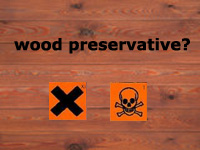 Wood exerts on many people a fascinating effect. Nevertheless, in Germany has the idea impressed that wood is always in danger of being destroyed by fungi or bacteria. Not for nothing is driving many homeowners in the construction markets, to buy chemical preservatives. After the wood preservative scandals in the seventies and eighties, some chemicals may however only be used outdoors. The Biocides Directive stipulates that products must contain hazards, and the contents are to be marked on the label. Ökotest had in his tests but found that hazards were often absent and the ingredients were not fully declared. The buyer of wood preservatives must assume that no product is free of toxins. Even products with RAL indicators are not health concerns. To structural components must be dare not even the layman. This is the responsibility of professionals.
Wood exerts on many people a fascinating effect. Nevertheless, in Germany has the idea impressed that wood is always in danger of being destroyed by fungi or bacteria. Not for nothing is driving many homeowners in the construction markets, to buy chemical preservatives. After the wood preservative scandals in the seventies and eighties, some chemicals may however only be used outdoors. The Biocides Directive stipulates that products must contain hazards, and the contents are to be marked on the label. Ökotest had in his tests but found that hazards were often absent and the ingredients were not fully declared. The buyer of wood preservatives must assume that no product is free of toxins. Even products with RAL indicators are not health concerns. To structural components must be dare not even the layman. This is the responsibility of professionals.
Which construction components are the builder’s favourite?
The non professional may address only components with non-functional or non- stiffening itself, ie components that are not subject to the building Use. These primarily include wall or cladding, windows, shutters and doors. Furthermore painted preferred fences, garden furniture, benches or fruit piles. According to European Biocide Directive containing a wood preservative at least one biocide. There are also a lot of solvents, which are inhaled by brush. So-called “biological” wood preservative without fungicides or insecticides are so far failed to provide proof of their lasting effectiveness guilty. Better use than chemistry is the selection of wood species for outdoor use. Douglas fir, larch or oak are resistant to weathering than spruce or fir. Pine is susceptible to blue stain.
What says the German DIN 68800 for chemical preservatives?
This DIN standard has been revised for many years and finally passed the 2011th Here is the structurally constructive wood protection is clearly a higher priority given to the chemical as preventive wood protection and clarifies that physical measures are to be preferred in general. The reason: Chemical wood protection measures are only a limited ability to compensate for long-term structural defects especially in moisture protection. In addition, pursuant to chemicals and hazardous substances, there is a bid avoid critical substances. Chemical protective measures under Part 3 of the standard, however, required in constructions where the combination of ensuring physical security measures in accordance with Part 2 of the standard and naturally durable wood species no protection success. For structural components that statement is formulated as a “must-determination”, for non-structural elements as “optional clause” is to be agreed separately.
Why the contamination with wood preservatives in indoor spaces is still an issue?
Until the late eighties indoors hardest wood preservatives were used. Pentachlorophenol (PCP) and lindane are the most prominent representatives. The health effects can be serious. Among other mucous membranes, lack of concentration, headaches, limb and muscle pain are called. In sum, there is often a chronic exhaustion and fatigue syndrome. Lindane acts as a neurotoxin. The symptoms may be tremor or muscle contractions. Both preservatives are classified as carcinogens. PCP and lindane have a very low vapor pressure and gases therefore slowly. PCP was banned in Germany end of 1989. Nevertheless, the poison is still found in homes. As part of a wood preservative restoration is to check whether a secondary contamination of wool carpets, cotton fabrics, wood or clothes there exists.
References in German:
www.oekotest.de/cgi/index.cgi?artnr=98218;bernr=01;co=
www.holzfragen.de/seiten/kommentierung_din_68800_teil_1.htm
www.umweltanalytik.com/lexikon/ing15.htm
